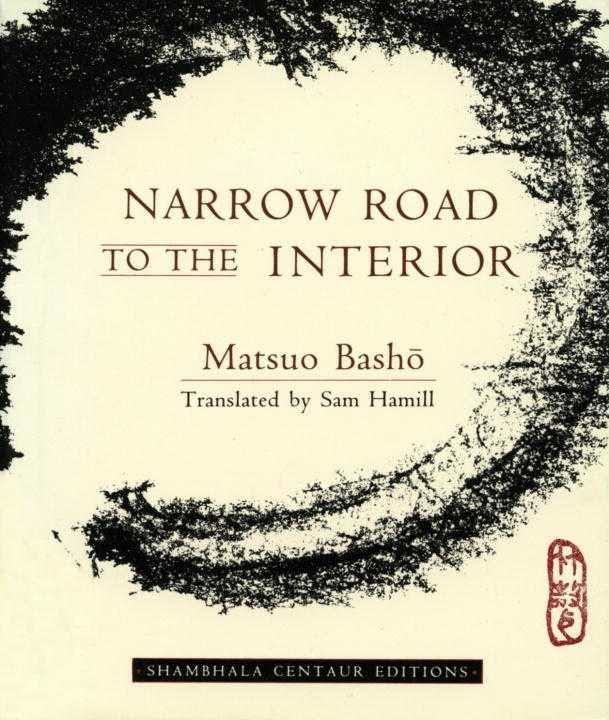7 /10 1 Votes7
| 3.5/5 Goodreads | |||||||||||||||||||||||||||||||||
 | ||||||||||||||||||||||||||||||||||
Similar Tsurezuregusa, The Pillow Book, Man'yōshū, The Narrow Road to t, The Tale of the Heike | ||||||||||||||||||||||||||||||||||
Oku no Hosomichi (奥の細道, originally おくのほそ道, meaning "Narrow road to/of the interior"), translated alternately as The Narrow Road to the Deep North and The Narrow Road to the Interior, is a major work of haibun by the Japanese poet Matsuo Bashō, considered "one of the major texts of classical Japanese literature."
Contents
The text is written in the form of a prose and verse travel diary and was penned as Bashō made an epic and dangerous journey on foot through the Edo Japan of the late 17th century. While the poetic work became seminal of its own account, the poet's travels in the text have since inspired many people to follow in his footsteps and trace his journey for themselves. In one of its most memorable passages, Bashō suggests that "every day is a journey, and the journey itself home." The text was also influenced by the works of Du Fu, who was highly revered by Bashō.
Of Oku no Hosomichi, Kenji Miyazawa once suggested, "It was as if the very soul of Japan had itself written it."
Opening sentences
Bashō's introductory sentences are the most quoted of Oku no Hosomichi:
Plot
Oku no Hosomichi was written based on a journey taken by Bashō in the late spring of 1689. He and his traveling companion Kawai Sora (河合曾良) departed from Edo (modern-day Tokyo) for the northerly interior region known as Oku, propelled mostly by a desire to see the places about which the old poets wrote in an effort to "renew his own art." Specifically, he was emulating Saigyō, whom Bashō praised as the greatest waka poet; Bashō made a point of visiting all the sites mentioned in Saigyō's verse. Travel in those days was very dangerous, but Bashō was committed to a kind of poetic ideal of wandering. He traveled for about 156 days altogether, covering almost 1,500 miles (2,400 km), mostly on foot. Of all of Bashō's works, this is the best known.
This poetic diary is in the form known as haibun, a combination of prose and haiku. It contains many references to Confucius, Saigyō, Du Fu, ancient Chinese poetry, and even The Tale of the Heike. It manages to strike a delicate balance between all the elements to produce a powerful account. It is primarily a travel account, and Bashō vividly relates the unique poetic essence of each stop in his travels. Stops on his journey include the Tokugawa shrine at Nikkō, the Shirakawa barrier, the islands of Matsushima, Hiraizumi, Sakata, Kisakata, and Etchū. He and Sora parted at Yamanaka, but at Ōgaki he briefly met up with a few of his other disciples before departing again to the Ise Shrine and closing the account.
After his journey, he spent five years working and reworking the poems and prose of Oku no Hosomichi before publishing it. Based on differences between draft versions of the account, Sora's diary, and the final version, it is clear that Bashō took a number of artistic liberties in the writing. An example of this is that in the Senjūshu ("Selection of Tales") attributed to Saigyō, the narrator is passing through Eguchi when he is driven by a storm to seek shelter in the nearby cottage of a prostitute; this leads to an exchange of poems, after which he spends the night there. Bashō similarly includes in Oku no Hosomichi a tale of him having an exchange with prostitutes staying in the same inn, but Sora mentions nothing.
Philosophy behind the text
Nobuyuki Yuasa notes that Bashō studied Zen meditation under the guidance of the Priest Buccho, though it is uncertain whether Bashō ever attained enlightenment. The Japanese Zen scholar D. T. Suzuki has described Bashō's philosophy in writing poetry as one requiring that both "subject and object were entirely annihilated" in meditative experience. Yuasa likewise writes: "Bashō had been casting away his earthly attachments, one by one, in the years preceding the journey, and now he had nothing else to cast away but his own self which was in him as well as around him. He had to cast this self away, for otherwise he was not able to restore his true identity (what he calls the 'everlasting self which is poetry'"). Yuasa notes "The Narrow Road to the Deep North is Bashō's study in eternity, and in so far as he has succeeded in this attempt, it is also a monument he has set up against the flow of time."
